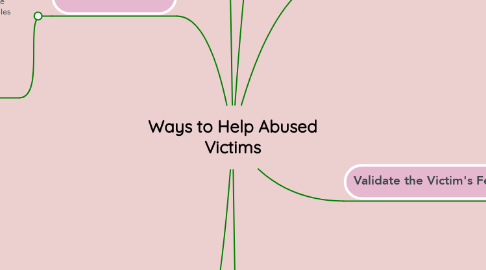Ways to Help Abused Victims
by Nadia Hamzah

1. Make Time For Them
1.1. If you decide to reach out to an abuse victim, do so during a time of calm. Getting involved when tempers are flaring can put you in danger. Also, make sure to set aside plenty of time in case the victim decides to open up. If the person decides to disclose years of pent-up fear and frustration, you will not want to end the conversation because you have another commitment.
2. Start a Conversation
2.1. You can bring up the subject of domestic violence by saying “I’m worried about you because …..” or “I’m concerned about your safety…" or "I have noticed some changes that concern me..." Maybe you've seen the person wearing clothing to cover up bruises or noticed that the person has suddenly become unusually quiet and withdrawn. Both can be signs of abuse. Let the person know that you will be discreet about any information disclosed. Do not try to force the person to open up; let the conversation unfold at a comfortable pace. Take it slow and easy. Just let the person know that you are available and offering a sympathetic ear.
3. Listen Without Judgment
3.1. If the person does decide to talk, listen to the story without being judgmental, offering advice, or suggesting solutions. Chances are if you actively listen, the person will tell you exactly what they need. Just give the person the full opportunity to talk. You can ask clarifying questions, but mainly just let the person vent their feelings and fears. You may be the first person in which the victim has confided.
4. Learn the Warning Signs
4.1. Many people try to cover up the abuse for a variety of reasons, and learning the warning signs of domestic abuse can help you help them: Physical Signs: Black eyes Busted lips Red or purple marks on the neck Sprained wrists Bruises on the arms Emotional Signs: Low self-esteem Overly apologetic or meek Fearful Changes in sleeping or eating patterns Anxious or on edge Substance abuse Symptoms of depression Loss of interest in once enjoyed activities and hobbies Talking about suicide Behavioral Signs: Becoming withdrawn or distant Canceling appointments or meetings at the last minute Being late often Excessive privacy concerning their personal life Isolating themselves from friends and family
5. Believe the Victim
5.1. Because domestic violence is more about control than anger, often the victim is the only one who sees the dark side of the perpetrator. Many times, others are shocked to learn that a person they know could commit violence. Consequently, victims often feel that no one would believe them if they told people about the violence. Believe the victim's story and say so. For a victim, finally having someone who knows the truth about their struggles can bring a sense of hope and relief. Offer the victim these assurances: I believe you This is not your fault You don't deserve this.
6. Validate the Victim's Feelings
6.1. It's not unusual for victims to express conflicting feelings about their partner and their situation. These feelings can range from: Guilt and anger Hope and despair Love and fear If you want to help, it is important that you validate their feelings by letting them know that having these conflicting thoughts is normal. But it is also important that you confirm that violence is not okay, and it isn't normal to live in fear of being physically attacked. Some victims may not realize that their situation is abnormal because they have no other models for relationships and have gradually become accustomed to the cycle of violence. Tell the victim that violence and abuse aren't part of healthy relationships. Without judging, confirm to her that her situation is dangerous, and you are concerned for her safety.
7. Offer Specific Help and Support
7.1. Help the victim find support and resources. Look up telephone numbers for shelters, social services, attorneys, counselors, or support groups. If available, offer brochures or pamphlets about domestic violence. You'll also want to help them get information on any laws regarding protective orders/restraining orders and child custody information. If the victim asks you to do something specific and you are willing to do it, don't hesitate to help. If you are unable to, try to find other ways the need can be met. Identify their strengths and assets, and help them build and expand upon them, so they find the motivation to help themselves. The important thing is to let them know that you are there for them, available at any time. Just let them know the best way to reach you if help is needed. If possible, offer to go along for moral support to the police, court, or lawyer’s office.


